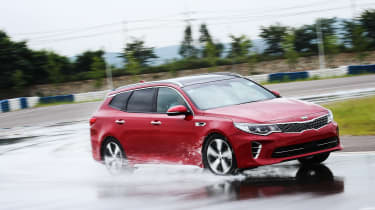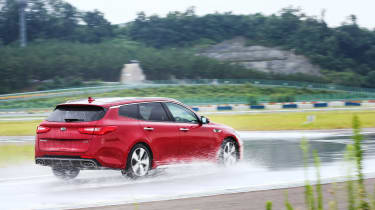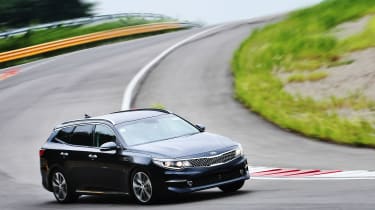Kia Optima Sportswagon review - Stylish looks; fun to drive?
Kia's new estate has the looks and the engineering focus, but it's not yet a 3-series Touring-lite
It’s hard to remember when Kia stopped being considered a cheap alternative to the more desirable mainstream European and Japanese brands, but cars like the Optima have undoubtedly contributed to the respect the company now commands in the market.
The Optima Sportswagon is, as the name suggests, an estate version of that car. A damn handsome one at that, and a practical one thanks to 552 litres of boot space with the seats in place and 1686 litres with them flattened. With an ex-BMW M man now driving Kia’s chassis team, good things are promised of its road manners, too.
Engine, performance and 0-60mph time
UK-bound Optimas will get a 1.7-litre CRDi turbodiesel four-cylinder as standard. It makes 139bhp – a mere 5bhp more than before – and 251lb ft of torque, 12lb ft more than the old car.
It’s slightly more refined than the engine it replaces but the real improvements are economical, with a combined figure of 64.2mpg (and 113g/km of CO2), particularly competitive for the segment. That’s with the six-speed manual gearbox; a seven-speed DCT is optional, and drops those figures to 61.4mpg and 120g/km.
The manual is the quickest too, albeit unlikely to trouble the average diesel 3-series Touring or similar: 0-60mph takes 9.8sec. The DCT manages 10.7sec. Quickest, and most frugal, is the new Optima PHEV, a plug-in hybrid (only available as a saloon, for the time being). It develops 202bhp, 274lb ft, and hits 60mph in 9.4sec – with a claimed 176.6mpg average.
Technical highlights
The new Optima Sportswagon benefits from all the improvements wrought to the regular Optima saloon. With direction from Albert Biermann, ex-BMW M, the Optima gets serious engineering changes and smaller detail tweaks to improve it in almost every area.
More reviews
Group tests
- Aston Martin Vantage V600 v Aston Martin Vantage GT8 – limited-run Astons go head-to-head
- Aston Martin Vantage vs Audi R8 V10 RWD – back to basics
- BMW E30 M3 v E46 M3 CSL v F87 M2 CS
- BMW M8 Competition Gran Coupe vs Audi RS7 Sportback – battle of the alt-supersaloon
- Caterham Super Seven 600 v Super Seven 2000
- Levante v T1
- Corvette Stingray v Porsche Cayman GTS v Audi R8 RWD
- Hardcore Ferrari V8 specials go head-to-head
- Evolution of the Ferrari GT: 365 GTB4 Daytona to the 812 Superfast
- Lamborghini Aventador Ultimae v Lamborghini Countach
In-depth reviews
- Audi RS7 Sportback Performance review
- Bentley Continental R Mulliner: review, history and specs
- BMW M5 Touring (E61, 2007 - 2010): review, specs and buying guide
- BMW X7 review
- Cupra Leon review
- Genesis G70 review
- Ginetta G56 GTA review – a fabulous portal into the world of motorsport
Long term tests
- Alpina B10: end of term report
- Alpina B10
- Alpina B10
- Alpina B10
- Ford Mustang GT
- Ford Mustang GT
- Ford Mustang GT
- Hyundai i30 N Fast Fleet test – 8 months with the Korean hot hatch
- Mitsubishi Evo MR 340
- Mitsubishi Evo MR 340
Review
- New Aston Martin DBS 770 Ultimate review – 759bhp super-GT driven
- New Bentley Batur 2023 review – can it possibly be worth £1.65m?
- 2023 Chevrolet Corvette C8 Z06 review – the American 911 GT3?
- Kia EV6 GT-Line S prototype review – the EV that shows how it’s done
- BBR Supercharged Mazda MX-5 (ND) 2023 review – tuned 250bhp roadster driven
- MG4 Trophy 2023 review
Reviews
- Abarth 500e 2023 review
- AC Cobra 378 Superblower MkIV 2021 review – another V8 Cobra, but with a GM heart this time
- Alfa Romeo Tonale 2023 review – 276bhp Speciale version tested
- Alfa Romeo Giulia Veloce 2023 review
- Alfa Romeo Giulia GTAm 2021 review – if Porsche built a four-door 911 GT3 RS
- Alfa Romeo SZ: history, review and specs of an icon
- Alfa Romeo 1750 TBi
Over half the body shell is now high-strength steel. The electric power steering motor has moved from the column to the rack, for better feel. Feedback is also improved through the use of different tyres – Michelin Pilot Sport 3s on 18” wheels, rather than the old Nexens – and Kia has chased NVH improvements throughout the car.
The Sportswagon gets unique spring and damper settings to take account of its more rear-biased weight distribution and the likelihood of carrying heavier loads. And the brakes are larger than before on all models, taking advantage of the extra tyre grip.
What’s it like to drive?
The previous Optima was distinctly unmemorable to drive. So much so that I had to double-check my notes to remember anything about it, in order to offer some worthy comparison for the new model.
The good news is that the new car is a significant improvement. Between the new tyres and rack-mounted power assistance motor there’s now a more precise and evenly-weighted feel to the steering, and although it’s not teeming with feedback it’s now quick and consistent enough to place the car accurately through corners, and determine when you’ve breached the tyres’ limits.
It feels more agile too, a factor seemingly unaffected by the extra metal at the rear in the Sportswagon. It rides maturely too and isn’t as flummoxed in direction changes as the old car, though body roll is always lurking in harder cornering. But where a spirited drive in the old model would leave you feeling deflated, there's now some enjoyment to be had.
It’s not quite as sharp as say, a Mazda 6, but it now feels like a fully-developed chassis that more than justifies comparison with better-established rivals. Should be a good basis for the upcoming Optima GT, too.
Thankfully, the GT will have a more enthusiastic engine than the 1.7-litre diesel lump that UK-bound Optimas will receive. While it develops more power than before and it’s quieter too, it just doesn’t feel strong enough to propel what is a relatively heavy car – up to 1605kg with the dual-clutch auto.
We tried both – the manual is slick, easy-to-use, not particularly tactile, the auto smooth and relaxing – but even with enthusiastic cog-swapping the Sportswagon always felt a bit of a sluggard. Kia admits that a larger engine would improve the experience, but we suspect the business case would be slim – the Optima is not a big seller in the UK.
The hybrid, as its power figures suggest, felt much more lively. With a six-speed automatic it didn’t have the CVT-style rise-and-fall engine note that hinders many hybrids but did have the welcome low-down urge and silent low-speed progress.
With eco-biased tyres it’s no sports saloon, but it’s indicative of Kia’s improvements that even this distinctly un-sporty model is better to drive than any previous Optima. It's probably the pick of the range.
Price and rivals
An Optima Sportswagon CRDi ‘2’ starts at £22,295. You’ll pay £24,495 for a higher-spec ‘3’, another £1400 for that car with the dual-clutch auto, and £30,595 for the DCT-equipped GT-Line S model.
The hybrid starts at £31,495, a price that includes the UK government’s £2500 plug-in car grand for eligible plug-in hybrids (certain full electric cars get a larger £5000 grant).
Rivals are numerous, and while most customers seem to be flocking to crossovers these days it’s still possible to find a good old fashioned estate in this market. Ford’s Mondeo is one (vast, and not the entertainer it used to be). Mazda’s stylish 6 Tourer is another. At £22,425 it’s priced similarly to the entry-level Kia but offers more power (even at its most basic) and a more involving drive.






